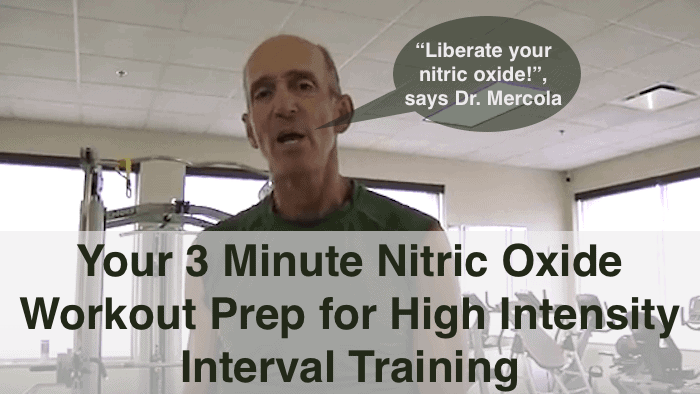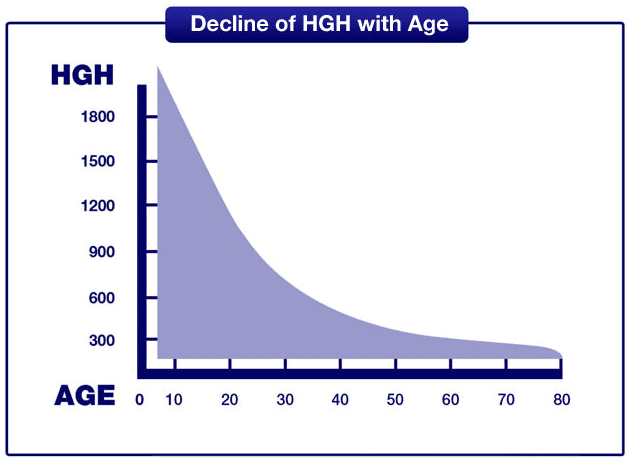Your 3 Minute Nitric Oxide Workout Prep for High Intensity Interval Training
A nitric oxide workout of 3 minutes 3 times per day can help make you bulletproof, says Dr. Mercola. Once you’ve got that tuned, turn to high intensity interval training for lean body composition and a boost of human growth hormone. [WATCH!]
{Updated 3/25/19}
I WANT to tell you about a Nitric Oxide Workout, because I got many emails asking about last week’s article about how to use the Lean Muscle Diet to improve your body composition.
In effect, I was asked, “What exercise should I do?“.
Of course, there’s a thousand answers to that question. I was pondering which among them I should suggest to my readers when my buddy and yogamaster Anatole came by.
Frequent readers may recall my Rainier Mountain climbing expeditions (here and here) with Anatole, a neighbor in the rustic hinterlands outside of Olympia, WA, where my mother lives and where I’m now typing away.
Anatole’s visit wound up substantially modifying this article. I got the sense that this was going to happen about five seconds after he showed me a video of Dr. Joseph Mercola demonstrating his “Nitric Oxide Workout”. (See below.)
My original intention was to write about HIIT — “High Intensity Interval Training”, because it’s the most effective way of quickly improving lean body composition (more muscle, less fat) in both men and women. But there’s a problem with HIIT at the outset for most of us — it’s simply too hard to do without substantial preparation.
HIIT is hard for two fundamental reasons:
- HIIT quickly overloads the body with oxygen deprivation and lactic acid; and
- Many of the HIIT exercise regimes are hard on the joints and can strain muscles.
Say, for instance, you’ve been lounging on the couch for a several years, and one day are startled by the realization that you have more years behind you than before you. Better get it into gear, you think, as you leap from the couch, lace up your track shoes from 20 years ago and go do some sprints.
Well, assuming you don’t pull a hamstring, calf or groin, the sprinting will work wonders on your body, including a big nitric oxide boost. That is, if you don’t injure yourself first. The odds of not injuring yourself before you look like sprinter Tyrone Edgar is slim to none.
Yes, HIIT — whether it be sprinting or burpees — is great for your body in many ways, but you must work up to it gradually in terms of intensity if you want to avoid injury.
In this article, you’ll discover:
- Why you want to boost nitric oxide
- The minimal workout to boost nitric oxide
- What supplements can boost nitric oxide
- How to begin high intensity interval training (HIIT)
- How HIIT boosts both human growth hormone and nitric acid
Let’s dig in…
The Minimal Nitric Oxide Workout to Boost NO (and Why You Want To)
 I’m going to get to Dr. Mercola’s demonstration of a three-minute nitric oxide workout in a few minutes, but first some background on nitric oxide (“NO”), guided by no other than the man who won the Nobel Prize in medicine for his research into it, Dr. Louis Ignarro.
I’m going to get to Dr. Mercola’s demonstration of a three-minute nitric oxide workout in a few minutes, but first some background on nitric oxide (“NO”), guided by no other than the man who won the Nobel Prize in medicine for his research into it, Dr. Louis Ignarro.
In his article, Nitric Oxide in Health and Disease, Dr. Ignarro says that NO functions as a widespread signaling molecule throughout the body, and provides the following roles/functions:
- Vasodilation to decrease blood pressure and improve organ blood flow

- Prevent unwanted blood clotting and obstruction to blood flow in arteries,
- Anti-inflammatory action in arteries to keep up a healthy arterial inner lining without cholesterol plaque buildup
- Promotes learning, memory and information recall in the brain
- Aids in the digestive process by promoting movement of digested foods and regulating secretion of digestive hormones and enzymes
- Regulates bladder function by allowing the bladder to expand and hold more urine
- Promotes erectile function and sexual arousal in men and women
- Protects the skin against ionizing radiation from the sun
Like a lot of things in the body, NO production declines as we age and can put us at risk for many disorders and diseases, such as:
- Hypertension or high blood pressure
- Stroke
- Myocardial infarction or heart attack
- Dementia such as Alzheimer’s disease
- Irritable bowel and related disorders in the digestive tract
- Urinary incontinence especially in elderly women
What all this means is that your body’s production of nitric acid is very important for robust health, and yet it plummets after age 30. Though this is true, there’s something we can do about it!
Exercise Boosts NO Production
The most common way to increase nitric oxide is through exercise. When you run or lift weights, your muscles need more oxygen which is supplied by the blood. As the heart pumps with more pressure to supply the muscles with blood, the lining in your arteries releases nitric oxide into the blood, which relaxes and widens the vessel wall, allowing for more blood to pass though.
As we age, our blood vessels and nitric oxide system become less efficient due to free radical damage, inactivity, and poor diet, causing our veins and arteries to deteriorate. Think of a fire hose as water rushes through it to put out a fire – it needs to expand enough to handle the pressure, still keeping enough force to put out the fire. Athletes and youth have the most ideal nitric oxide systems, reflecting their energy and resilience.
The good news is that NO goes up every time you exercise as long as your heart rate goes up by at least 10 or 20 beats per minute. You don’t have to run a marathon or bicycle up hill for hours to increase your NO production. Walking briskly, jogging slowly, climbing stairs, playing tennis, swimming will do the trick, as well as the 3-minute exercise sequence Dr. Mercola is about to show us.
As you watch Dr. Mercola’s video, remember this:
- Do this 3-minute exercise sequence three times per day, 9 minutes total
- Allow at least two hours to pass in between sessions
- There are four exercises…
- Squat
- Alternating arm scissors
- Jumping jack arms
- Shoulder press
- Breathe through your nose
Tips:
- Squat — separate feet at least shoulder width apart. (Mercola’s stance is too narrow.) Point toes slightly out and makes sure your knees track over your feet as you squat. Put your weight in your heels. Begin the squat by sticking your butt out as if you are going to sit in a chair.
- Alternating arm scissors — move your arms vigorously.
- Jumping jack arms — rotate your hands out, palms facing away from you, as they rise to chest level and above.
- Shoulder press — make sure that your elbows and forearms are slightly behind your ears so that you can contract your shoulder blades as you do the movement.
- Nose breathing — try to find a rhythm of breathing connected to the movements such that you don’t get breathless. Don’t get anxious about this. If needed, take a few gulps of air by mouth and then return to nose breathing. (Search for ujjayi breath in this article I wrote about meditation.)
Now to Dr. Mercola, who demonstrates a nitric oxide workout technique taught to him by Dr. Zach Bush:
I must admit that Anatole and I were invigorated and felt modestly exercised after doing this Nitric Oxide Workout, but neither of us would opt to replace all the other exercise we do for this one.
My suggestion is that how you use this routine should be based on your fitness level and what you want to do:
- Non-exercisers — begin with this routine and once you do it regularly, step into a beginners HIIT program like one described below.
- Non-exercise days — during days of rest you can keep the NO going with this routine that’s gentle enough not to compromise your scheduled workouts.
- Warm-up — get your muscles fired up and some basic joints lubricated before you begin your workout.
Supplements Can Boost NO Production
You can amplify the NO production garnered by exercise with supplements.
You can supplement your healthy lifestyle by consuming foods and nutritional supplements that are scientifically known to increase nitric oxide levels. Such foods include healthy protein and antioxidants found in colorful vegetables and fruit.
Nutritional supplements include those containing specific amino acids and antioxidants the body uses to produce NO, such as:
- L-arginine, and
- L-citrulline.
Since NO declines appreciably with age, Dr. Ignarro suggests that men and women begin taking such nutritional supplements at a relatively young age, such as between 20 and 35 years of age, although he underscores that it’s never too late, “because you will still enjoy the health benefits of nitric oxide at any age.”
I found Dr. Ignarro’s take on NO’s effect on estrogen to be particularly interesting.
He strongly recommends that women take supplements to boost their nitric oxide, preferably beginning years before menopause, because their estrogen declines sharply during and after menopause.
Estrogen is well known to stimulate the production of NO, which means that prior to menopause when women’s bodies make an abundance of estrogen, they produce more NO than do men of equal age. Consequently, prior to menopause, women are more protected than are men of equivalent age against cardiovascular disease associated with low levels of NO, such as stroke and heart attack. However, the sharp decline in estrogen production after menopause causes a simultaneous decline in NO production and thereby increases the risk for stroke and heart attack in women compared with men of the same age.
What, therefore, should women do?
As mentioned, Dr. Ignarro advises that, as with men, women begin to boost their nitric oxide levels between 20 and 35 years of age and continue to do so daily for a lifetime, particularly post-menopause. And, of course, we can add to this advice that you regularly do the Nitric Oxide Workout demonstrated by Dr. Mercola.
Which supplement brand to take?
I have no personal experience with L-arginine, and L-citrulline, the two amino acids that are the primary supplements that can boost NO, so I checked out what is recommended by the subscription-based service, ConsumerLabs. Their advice is to choose a product that lists the amounts of L-argnine and L-citrulline and that six grams per day not be exceeded.
NOW Sports Arginine & Citrulline is a good brand and lists 500 mgs of L-arginine and 250 mgs of L-citrulline. Amazon.com’s choice is Dr. Emil L Aginine, perhaps based on positive reviews and sales volume.
HIIT for HGH and A Nitric Oxide Workout
Now we get to HIIT, “High Intensity Interval Training”.
If you’re inclined to read exercise articles you bump into whilst cruising the Net, you’ve undoubtedly read about HIIT. Yes, it’s in vogue, and for good reason — there’s no faster, better way to get fit than with HIIT.
High Intensity Interval Training alternates between high-intensity and low-intensity exercise. For example, sprinting for 30-seconds, then walking for 60-seconds is high intensity interval training. HIIT can be used both anaerobically in the gym with weights and aerobically with cardio.
But, as menti0ned at the outset of this article, HIIT is a recipe of injury unless you ease into it smartly, which is one reason I suggested that if you’re not already an active exerciser, begin with the NO boosting routine demonstrated by Dr. Mercola.
Why bother with the body-warping intensity of HIIT if Dr. Bush’s much easier exercise method will boost nitric oxide?
My answer is that HIIT will give you both a big dose of NO and HGH (human growth hormone), a potent combination.
High intensity interval training (at 85% to 90% of VO2max) is more effective in improving endothelial function and nitric oxide availability than continuous moderate aerobic exercise. These studies were done in humans and rats with metabolic syndrome and found that high intensity interval training reversed more risk factors of metabolic syndrome than did continuous moderate aerobic exercise. (1, 2)
Although not tested (as far as I know), these same benefits would extend to Dr. Bush’s Nitric Oxide Workout, as performed by Dr. Mercola.
I’ve written several articles about HIIT; this one featuring Dr. Mercola, where I made the following points:
- Take is slowly, even if you exercise regularly. The fastest way to injure yourself is to go fast (like sprinting) when you’re accustomed to going slow (like jogging). As I learned the hard way, going to hard too fast will probably cause an injury that will take a long time to recover from.
- Try different HIIT methods. You can experiment with different “on” (say sprinting) and “off” (walking) durations, and different “sets” (like doing each on/off eight times).
- Whatever number of sets you set for yourself, do them, but don’t start out by trying to do them all with the same intensity. For instance, after warming up, if you’re a jogger you may do four sets at three-quarters speed, and four at half speed until you build up the capacity to go all out for all eight sets. Mind you, even for an Olympic athlete, the last set will be far slower than the first, and that’s by design – the whole point of HIIT is to overload your capacity to do the work.
- Alter your other exercise programs. Adding HIIT to your exercise regiment will affect all other exercise. You will have to do less of everything else, simply because you’ll be wiped out.
- Give yourself enough rest. As I said, you’ll be wiped out, and thus will need to rest. The older you are, the more rest in between HIIT sessions you’ll need. I sprint stairs for my HIIT and can only do them twice a week. In between those two HIIT days, I do resistance training (weights or calisthenics) and yoga, but modulate the intensity.
- Rest. A lot! A HIIT program is an assault on your musculature and nervous system. In addition to proper rest and nutrition, you’re going to have to stretch all the major muscles in your body. This will help them repair and recover and be more resistant to injury.
With all that in mind, let’s turn to Marc Perry, Founder of BuiltLean (and he is). In his article, High Intensity Interval Training (HIIT): Best Cardio to Burn Fat, Marc presents a good intro to HIIT and a much needed suggestion for beginners.
Marc begins with this photo to make the same point I did with the picture of Tyrone Edgar:
The fella on the left has built his body from steady state cardio (aerobic) conditioning, where the fella on the right built his body doing high intensity interval training cardio (anaerobic) conditioning. The choice is yours.
Why Is HIIT the Best Cardio to Burn Fat?
Once upon a time, exercise physiologists thought “steady state” cardio was superior for fat loss because relatively more fat is used by the body as fuel at lower exercise intensities than at higher intensities. You see this indicated to this day on cardio equipment that shows the so-called “Fat Burning Zone” to be 60%-65% of max heart rate as ideal for burning fat.
Not so.
While it’s true that more fat is “burned” relative to glycogen use when, say, walking, the focus should be on total fat burned; meaning, the amount of fat burned not just during the exercise, but for hours afterwards. At higher exercise intensities, you’ll be burning far more fat over the course of the exercise period plus hours after than occurs with low intensity exercise.
This is referred to as the afterburn effect known as EPOC (excess-post exercise oxygen consumption). You increase your metabolism and burn more calories for up to 24 hours after interval training, where going for a jog burns almost zero calories afterwards.
HIIT Benefits
It’s not all about fat burn — there are a number of other great benefits to High Intensity Interval Training besides serious fat burn, writes Marc Perry, such as:
- Increased Aerobic Capacity – The amount of oxygen your body can use (oxygen uptake) is increased, so your overall aerobic capacity can increase faster than with low intensity endurance exercise.
- Increased Lactate Threshold – Your ability to handle increased lactic acid buildup in your muscles increases.
- Improved Insulin Sensitivity – Your muscles more readily suck in glucose, instead of the glucose going to your fat stores.
- Anabolic Effect – Some studies show that interval training combined with consuming slightly more calories than you burn creates an anabolic effect, which helps you put on muscle. The opposite occurs with steady state, long duration cardio, which is catabolic.
Three HIIT Workouts
If you are a beginner, Marc Perry recommends attempting HIIT only if you can do a session of cardio for 20-30 minutes at 70-85% of your max heart rate. You can still try interval training, but at a lower exercise intensity. To make sure you’re in the right heart rate zone, beginners should always wear a heart rate monitor.
Marc also underscores the need to warm up prior to your HIIT session. I can’t empathize this more strongly. If you’re not (1) physically ready to begin a HIIT routine; and (2) haven’t thoroughly warmed up before you begin it, then you’re destined for injury.
Spend at least three to five minutes warming up and end with the same amount of time spent cooling down.
1. Sprint/Walk
This one comes from Marc Perry; the next me and the last from Dr. Mercola.
The Sprint/Walk HIIT:
- 30 Seconds Sprint/Fast Jog
- 60 Seconds Walk/Slow Jog
- 5 to 1o Sets
Like all HIIT-type exercises, you can dial in the intensity on this one relative to your preparation and conditioning.
Marc applies this 30sec/60sec cadence to HIIT workouts involving a treadmill, jumping rope, or doing kettlebell swings.
The duration of “work” is 30 seconds, and the “rest” is 60 seconds. The work/rest ratio in this case is 30/60, or 1 to 2.
His aim is for 5-10 sets, depending on the type of cardio he’s doing and whether he was strength training beforehand. You’ll see in a moment that I do my HIIT sessions before strength training so it can better benefit better from the human growth hormone produced by the HIIT.
Obviously, the better shape you are in, the higher intensity you can handle and the higher the work/rest ratio. For example, well trained athletes can use a 2 to 1 work /rest ratio, so they are training hard for 30 seconds and only resting for 15 seconds. That’s tough, but also possibly counterproductive, given that rest periods that are too short will not enable sufficient exertion within proper training parameters. This simply means that if your form suffers too much, there’s diminishing marginal returns from your effort.
How often?
Counterintuitively, I think that beginners can do more HIIT sessions than conditioned athletes, particularly if the athletes do other forms of exercise throughout the week and if their over 40 years of age.
Beginners cannot (or should not) put out an extreme effort that then necessitates multiple-day recovery periods in between HIIT sessions. In contrast, a well-conditioned athlete can completely wipe him or herself out and thereby need at least two days of recovery, perhaps three days if older than 40.
2. Sprint Up /Walk Down
This is how I mostly do HIIT — I warm up and then sprint up a long flight of outdoor, concrete stairs in the hills of Sausalito, CA. A nearly flat-out effort, it takes 30 seconds to get to the top of the stairs, after which I take a few breaths and slowly walk down, then pause at the bottom till a total of 90 seconds has elapsed from the finish of the last set and the beginning of the second.
The Sprint Up/Walk Down HIIT:
- 30 Seconds Sprint/Fast Jog
- 90 Seconds Walk Down/Rest
- 5 to 8 Sets
Why this ratio of action/rest?
As you’ll see next up with Dr. Mercola’s HIIT, his advisor, exercise physiologist Phil Campbell, has studied that most effective HIIT ratios and it’s 30 seconds “on”, 90 seconds “off”, 8 sets, he says.
The reason I sometimes only do five sets is simply because I get too pooped to do more. On a “good” day, I begin with like this (after my warm up):
- Set 1: about 50% effort (basically, slow jog up the stairs)
- Set 2: 75% effort
- Set 3 – 8: as much as I can muster, which means by the last set I’m barely shuffling and breathing like a choo choo train.
I then hobble down to the playground where I do calisthenics, such as pull-ups and push-ups.
Why do strength training after HIIT?
Well, it depends what you’re after. Surely, if you want a strong strength training session, don’t do HIIT first, but if you want some human growth hormone surging through your body before strength training to give an extra stimulus to muscle-building, then do HIIT first. I describe this in my article, Boost Your Human Growth Hormone In 20 Minutes, which begins like this:
“Watch Dr. Mercola and exercise physiologist Phil Campbell do a 20-minute exercise protocol that can stimulate your own production of HGH by 771%. HGH levels and telomere length are indicators of life span and health.”
As you age, human growth hormone declines fast. If you can, it’s a good idea to resist.
3. Elliptical Sprint /Elliptical Walk
In this last example of a HIIT routine, Dr. Mercola is guided by Dr. Phil Campbell, a world-renown HIIT expert. He uses an elliptical machine and the same system as mine: 30 seconds on, 90 off, 8 sets.
Your Takeaway
OK, how should we put this NO and HIIT information together?
It’s simple really, because it all comes down to what you’re willing to do, or can do.
If you know that HIIT is simply not something you’re going to do consistently, than do the Dr. Bush/Mercola Nitric Oxide Workout, for surely it’s easier than HIIT and very useful at boosting nitric oxide, which as a plethora of health benefits, as listed above.
If you want to try HIIT, just start slowly. Perhaps warm up with the Nitric Oxide Workout first.
You may also choose to supplement with L-arginine, and L-citrulline, but frankly, I wouldn’t rely on that. It’s always a good idea to get off the couch and move at every opportunity.
So, get up –> get going.
Last Updated on April 11, 2023 by Joe Garma










